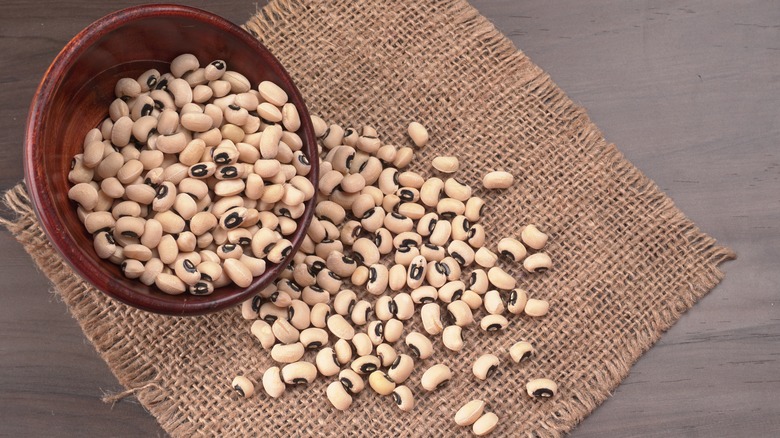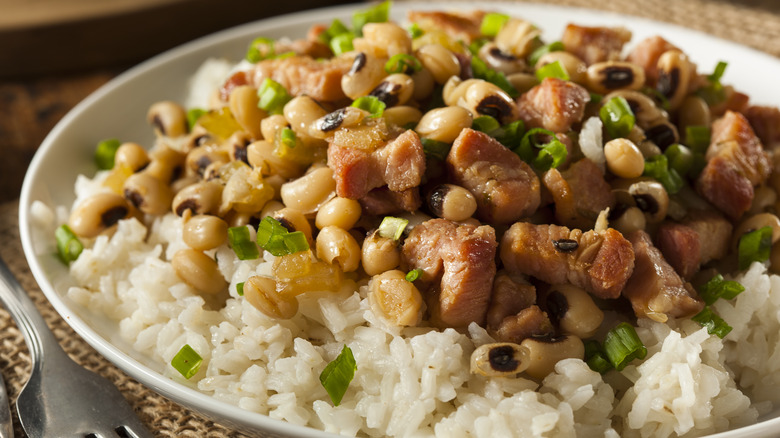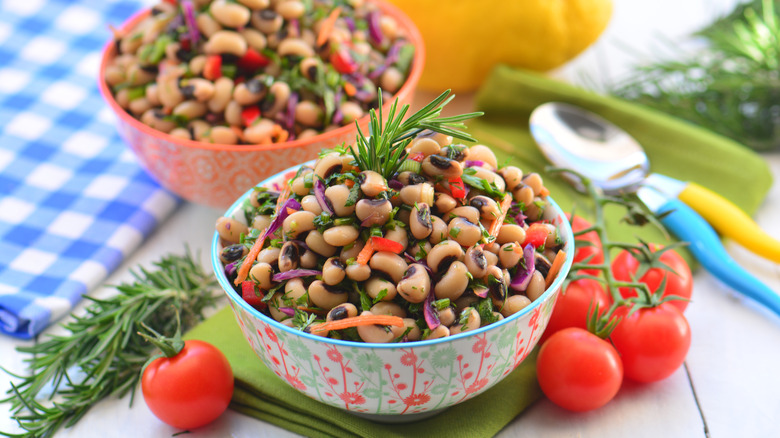What Exactly Are Black-Eyed Peas? (No, Not The Musical Group)
Many aspiring chefs are eager to try new foods and ingredients, even if they know little about them. Sometimes, what matters most is the flavor. For example, you might have heard of black-eyed peas, but do you know where they come from? Are they beans, peas, or vegetables? Despite their name, black-eyed peas are actually beans. They belong to the Leguminosae family, which also includes peas, soybeans, lentils, peanuts, and jicama. What differentiates them from other beans is the black dot in the middle.
Black-eyed peas have a rich history and symbolism, being associated with good fortune. These southern gems originated in West Africa, but they became a staple of Creole and Cajun cuisine. Legend says they attract prosperity, protect against the evil eye, and bring good luck in the New Year. For this reason, they are commonly used in Hoppin' John, a traditional New Year's Eve dish dating back to the 18th century. The beans represent coins, while other ingredients, such as tomatoes and cornbread, are thought to bring abundance and good health.
These little legumes are also a nutritional powerhouse, offering 40 grams of protein and 16 grams of fiber per cup. Their mild, earthy flavor is ideal for soups, stews, and even desserts. Plus, they hold their shape well and have a creamy texture when cooked, making them a versatile ingredient in salads and meat dishes.
Black-eyed peas, a versatile bean that will elevate your cooking game
Cowpeas, or black-eyed peas, have been around since prehistoric times. Centuries ago, they were used as animal feed but later became an integral component of Southern cuisine. Today, they are a key ingredient in sambal goreng, Texas caviar, acarajé, cook-up rice, and other recipes from around the world. Their distinct appearance, quick cooking time, and versatile flavor are hard to match.
As you might have noticed, these legumes have a black spot where the seed attaches to the pod. They're usually pale in color and become light brown when cooked, but some varieties are green, orange, black, or gray. Like other beans, they pack hefty amounts of protein, iron, potassium, calcium, and complex carbs. The fiber in black-eyed peas increases satiety and keeps you regular, while folate and other nutrients support pregnancy health. Cowpeas are also an excellent source of manganese, a mineral involved in energy metabolism.
From a culinary perspective, black-eyed peas can be a delicious addition to both savory and sweet dishes. You may add them to stir-fries, casseroles, cauliflower rice, chicken enchiladas, brownies, pies, and everything in between. For example, you could surprise your loved ones with Vietnamese rice pudding, or Che Dau Trang, a traditional dessert made with sticky rice, black-eyed peas, pandan leaves, sugar, and coconut cream. The beans will absorb the flavors of the other ingredients without overpowering them.
How to cook black-eyed peas for a gourmet experience
Most stores sell dried black-eyed peas, so you'll need to soak them overnight. Another option is to brine your beans in baking soda to soften them and reduce cooking time. If you prefer to use canned black-eyed peas, rinse them well before eating. Rinsing the beans can decrease their sodium content by over 40%, though it may also result in nutrient loss. The advantage is that they'll taste better and have less salt, making them safer for those with high blood pressure.
Next, add the beans to salads and other raw dishes, or use them in cooked meals. Blend them into hummus, serve them with sausages, or use them as a meat substitute in veggie patties and vegan burgers. If you're having a sweet tooth, mix the beans with cocoa powder, dark chocolate, oats, vanilla, and other pantry staples to make brownies.
Black-eyed peas can also be sprouted, which enhances their nutritional value. Eat the sprouted beans raw, sprinkle them over salads, or roast them for extra crunchiness. Alternatively, mash the beans and serve them on toast for a hearty breakfast. Add smoked paprika, cilantro, sage, rosemary, and other herbs or spices to boost their flavor.


